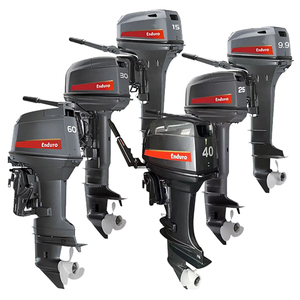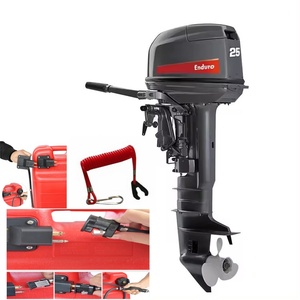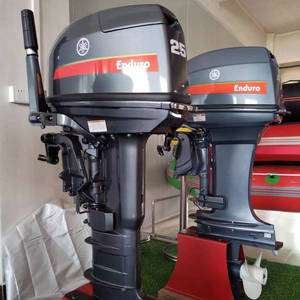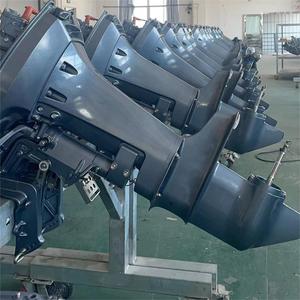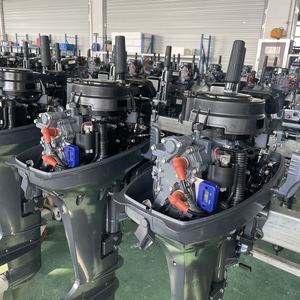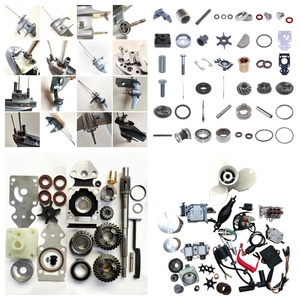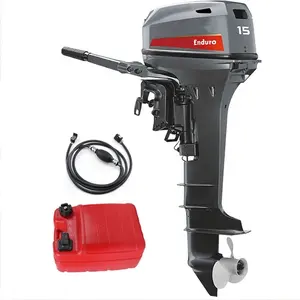Types of Yamaha Boat Engines
Yamaha boat engines are categorized into two main types based on their configuration and the technology they use to generate power. Each type offers distinct advantages for different boating needs and environments.
Four-Stroke Outboard Engines
Yamaha boat engines with four-stroke technology are designed with environmental consciousness and user comfort in mind. These engines feature:
- Enhanced fuel efficiency through optimized combustion processes
- Significantly reduced noise levels for peaceful boating experiences
- Lower emissions, making them environmentally friendly
- Stable idling performance and smooth operation
- Simplified maintenance with fewer moving parts
- Advanced lubrication systems that extend engine life
Best for: Recreational boating, fishing in quiet waters, eco-conscious boaters, and long-distance cruising
Two-Stroke Outboard Engines
These Yamaha boat engines offer practical advantages for specialized applications and are characterized by:
- Lightweight and compact design for easy transportation
- Simple mechanical construction with fewer components
- Superior power-to-weight ratio for quick acceleration
- Excellent performance in shallow water conditions
- Efficient cooling systems preventing overheating
- Easy repairs and maintenance in the field
Best for: Racing applications, fishing in shallow waters, portable applications, and situations requiring quick acceleration
Expert Tip: While two-stroke engines are becoming less common due to environmental regulations, they remain valuable for specific applications where weight and power are critical factors. For general recreational use, four-stroke engines typically offer the best balance of performance, efficiency, and environmental compliance.
Specifications and Maintenance of Yamaha Boat Engines
Yamaha outboard motors offer a diverse range of specifications designed to accommodate various boating requirements. Understanding these specifications helps in proper selection and maintenance of your engine.
| Specification | Range/Details | Importance |
|---|---|---|
| Cylinder Arrangement | V4, Inline 2 or 3-cylinder | Affects engine balance and vibration |
| Displacement | 498 to 4260 cc | Determines potential power output |
| Bore and Stroke | 60-110 mm bore, 70-130 mm stroke | Influences engine efficiency and torque |
| Fuel System | EFI or HPDI injection | Affects fuel efficiency and emissions |
| Ignition System | CD or TCID electronic systems | Determines reliability and starting ease |
| Starting System | Electric or manual start | Convenience factor for operation |
| Cooling System | Water-cooled with thermostat | Critical for engine longevity |
| Lubrication | Separate or mixed systems | Impacts maintenance requirements |
| Weight | 17 to 442 kg | Affects boat balance and performance |
| Dimensions | L: 800-1500 mm, W: 310-1050 mm, H: 1050-2200 mm | Determines installation compatibility |
| Propeller Shaft Output | 8.5 to 440 kW | Defines usable power for propulsion |
Essential Maintenance Practices
Regular maintenance is crucial for ensuring the reliability, performance, and longevity of your Yamaha boat engine. Follow these key maintenance practices:
Routine Maintenance
- Regular Oil Changes: Replace engine oil according to the manufacturer's schedule to remove contaminants and ensure proper lubrication
- Propeller Inspection: Regularly check for damage, wear, or debris that could affect performance and efficiency
- Scheduled Professional Service: Have your engine inspected by authorized Yamaha technicians to identify potential issues early
- Genuine Parts Usage: Always use authentic Yamaha parts for replacements to maintain reliability and warranty coverage
Seasonal Maintenance
- Pre-Season Preparation: Complete a full inspection before the boating season begins
- Saltwater Considerations: Flush the engine with fresh water after use in saltwater environments
- Winter Storage: Properly winterize your engine with fuel stabilizer and appropriate storage procedures
- Corrosion Prevention: Apply protective coatings and sacrificial anodes to prevent corrosion damage
Important Warning: Neglecting regular maintenance can lead to significant engine damage, reduced performance, and costly repairs. Always follow the maintenance schedule outlined in your Yamaha owner's manual and keep detailed records of all service performed.
How to Choose Yamaha Boat Engines
Selecting the ideal Yamaha boat engine requires careful consideration of multiple factors to ensure optimal performance for your specific boating needs. Use this comprehensive guide to make an informed decision.
| Selection Factor | Considerations | Recommendation |
|---|---|---|
| Power Requirements | Required horsepower (HP) depends on boat size, weight, and desired performance | General rule: 1 HP per 40-50 lbs of boat weight for optimal performance |
| Fuel Type | Availability, cost, and efficiency of different fuel options | Gasoline engines for general use; diesel for long-range cruising |
| Environmental Regulations | Local emission standards and restrictions | Four-stroke or clean-technology two-stroke engines for environmentally sensitive areas |
| Usage Type | Recreational, commercial, or specialized activities | Match engine series to specific application (F series for recreational, V MAX for performance) |
| Service & Maintenance | Accessibility of service points and availability of parts | Consider local dealer network and service support |
| Noise & Vibration | Comfort considerations for passengers | Four-stroke engines generally offer quieter, smoother operation |
| Weight Considerations | Impact on boat stability and performance | Balance engine weight with boat capacity; consider transom strength |
| Cooling System | Operating environment and water conditions | Enhanced cooling systems for warm water or high-load applications |
| Warranty & Support | Manufacturer backing and service network | Review Yamaha's warranty terms and local dealer reputation |
| Budget | Initial cost, operating expenses, and long-term value | Consider total cost of ownership beyond purchase price |
Expert Selection Tip: For most recreational boaters, the Yamaha F series four-stroke engines offer an excellent balance of reliability, fuel efficiency, and quiet operation. For performance applications where speed is critical, consider the V MAX SHO series which combines four-stroke efficiency with high-output performance.
DIY Replacement of Yamaha Boat Engines
While replacing a boat engine can be a complex task, following a systematic approach can make the process manageable for those with mechanical aptitude. This guide outlines the key steps and considerations for a successful engine replacement.
Safety Warning: Engine replacement involves heavy equipment, electrical systems, and hazardous fluids. If you lack experience with marine mechanical systems, consider consulting a professional technician. Improper installation can result in personal injury, boat damage, or warranty violations.
Preparation Before Engine Replacement
Consult Documentation - Thoroughly review your Yamaha engine owner's manual and any available service documentation. Familiarize yourself with the specific requirements for your engine model.
Gather Required Tools - Collect all necessary tools including wrenches, sockets, screwdrivers, specialized marine tools, lifting equipment, and safety gear before beginning work.
Disconnect Power Sources - Remove all connections to batteries and power sources to prevent electrical accidents during the replacement process.
Prepare Fluid Management - Have appropriate containers ready for draining and disposing of engine oil, coolant, and fuel according to environmental regulations.
Engine Removal Process
Drain All Fluids - Carefully drain oil, coolant, and fuel from the engine system, collecting them in appropriate containers for proper disposal.
Disconnect Components - Remove all connections to the engine including electrical wiring, fuel lines, control cables, and cooling system components. Label each connection for easier reassembly.
Remove Mounting Hardware - Unfasten all bolts and brackets securing the engine to the boat's transom or mount points. Have assistance ready for supporting the engine's weight.
Extract the Engine - Using appropriate lifting equipment, carefully remove the old engine from its mounting position, maintaining stability throughout the process.
New Engine Installation
Prepare Mounting Location - Clean and inspect the engine mounting area, replacing any damaged hardware or mounts before installing the new engine.
Position New Engine - Carefully lower the new Yamaha engine into position, aligning with mounting points and ensuring proper orientation.
Secure Mounting Hardware - Install and tighten all mounting bolts according to the torque specifications provided in the engine documentation.
Connect Components - Reattach all connections including electrical, fuel, cooling, and control systems, referring to your labeling from the removal process.
Fill Fluids - Add the recommended types and amounts of oil, coolant, and fuel to the appropriate reservoirs.
System Check - Before starting, verify all connections are secure, fluid levels are correct, and no tools or debris remain in the engine area.
Initial Start and Testing - Start the engine and monitor for proper operation, checking for leaks, unusual noises, or vibrations.
DIY Pro Tip: Take photographs throughout the removal process to document the original configuration of connections, cables, and mounting hardware. These references can be invaluable during reassembly, especially for complex systems or if the project extends over multiple days.
Frequently Asked Questions
Yes, Yamaha boat engines require regular maintenance to ensure optimal performance and longevity. Key maintenance tasks include:
- Regular oil and filter changes according to the manufacturer's schedule
- Spark plug inspections and replacements at recommended intervals
- Cooling system checks to ensure proper water circulation
- Fuel system inspections to prevent contamination issues
- Valve clearance checks on four-stroke models
Following the maintenance schedule in your owner's manual is crucial for maintaining reliability, performance, and warranty coverage.
While most Yamaha boat engines are designed to run on conventional gasoline, there are important considerations regarding alternative fuels:
- Ethanol-blended fuels up to E10 (10% ethanol) are generally acceptable in modern Yamaha engines
- Higher ethanol blends (E15+) are not recommended and may void warranty
- Biofuel compatibility varies by engine model and year
- Significant modifications may be required for alternative fuel systems
Always consult with an authorized Yamaha dealer before using alternative fuels, as improper fuel usage can cause serious damage to engine components.
Yes, Yamaha boat engines are designed for use in both freshwater and saltwater environments, though saltwater requires additional maintenance considerations:
- Yamaha engines feature corrosion-resistant materials and protective coatings
- After saltwater use, thoroughly flush the engine with fresh water
- Apply appropriate anti-corrosion sprays to electrical connections
- Check and replace sacrificial anodes (zinc) regularly in saltwater applications
- Consider upgrading to saltwater-specific models for primary saltwater use
With proper care and maintenance, Yamaha engines can provide reliable service in even the harshest marine environments.
Yes, Yamaha offers several engine series specifically designed for high-performance applications:
- The V MAX SHO (Super High Output) series combines four-stroke efficiency with race-inspired technology
- XTO Offshore series provides extreme offshore power for larger vessels
- Performance-tuned models feature optimized gear ratios and advanced fuel injection
- These engines offer higher RPM ranges and improved acceleration characteristics
High-performance engines typically require more rigorous maintenance schedules and premium fuels to maintain optimal operation.
Locating authorized Yamaha marine dealers and service centers is straightforward through these resources:
- Visit the official Yamaha Marine website (yamahaoutboards.com) and use the dealer locator tool
- Enter your location or ZIP/postal code to find nearby authorized dealers
- Contact Yamaha customer service for personalized assistance
- Authorized dealers provide genuine parts, factory-trained technicians, and warranty support
Using authorized service centers ensures your engine receives proper care with genuine Yamaha parts and factory-approved procedures, maintaining both performance and warranty coverage.















